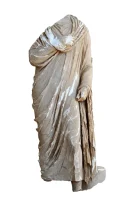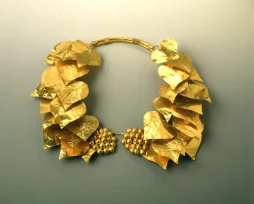When he leased the field outside Terpsithea of Larissa to sow cotton, he did not imagine that the milling machine, which he also leased to plow it, would bring out from the bowels of the earth a valuable archaeological treasure. Mr. Yannis from the neighboring village addressed the archaeological service and is now waiting for the establishment of a three-member committee – as decided by the KAS – to assess the ancient stele and assign him a sum of money as a reward.
“The farmer came and handed us an ancient stele, which he dug up from the field he leased. The central part of a tombstone, 1 meter high, is preserved, where a conversation between a man and a woman is recorded, and it dates back to Late Antiquity,” the head of the Ephorate of Antiquities of Larissa, Stavroula Sdrolia, who received the find and in one of its last meetings the Central Archaeological Council, set up a three-member committee to assess it and assign an amount of money to the farmer who delivered it.
ADVERTISING SPACE
The process for someone to get an index after finding antiquities in their private space is not easy, nor quick. The Archaeological Law stipulates that a three-member committee of experts must be set up to assess the find.
The Honorary General Director of Antiquities of the Ministry of Culture, Polyxeni Adam-Veleni, who has been appointed several times as a member of such a committee, explains to Voria that the process takes time, because the authenticity and the value of the ancient object must be proven on the one hand.
ADVERTISING SPACE
“The work of the committee members is difficult and time-consuming. We must first look for literature, see if it has parallels with the specific find, assess the value of the parallels, its rarity, the place where it was found, the state of preservation. The assessment is a multifactorial issue”, says Ms. Veleni.
The Thessalian plain is full of antiquities
The case of Mr. Giannis with the ancient stele is not the first nor the only one in the Thessalian plain. From time to time farmers plowing their fields find antiquities and hand them over to the Archaeological Service.
“Most people hand them over not to get money, but the law provides for a fee, so the local Antiquities Ephorates inform them of the procedure to be followed. The legislator has planned to thank in this way those who bring antiquities and help to reconstruct history. Of course, we know that many choose other ways, e.g. to keep them or channel them through illegal channels abroad and sell them”, points out Ms. Veleni.
ADVERTISING SPACE
The head of EFA Larisa remembers at least two cases recently, in which farmers found antiquities in their fields and handed them over. Both concerned the archaeological site at Kastri, a fortified citadel of the early Byzantine period, located between Dolihi and Livadi Olympos. Kastri is surrounded by the Saradaporos river and its tributaries, an element that made it a fortified place during Byzantine times, which controlled the routes from Macedonia to Thessaly.
“In one case, a farmer found a statue during cultivation work in a rented field and it is typical that a fee was given both to him and to the owners of the field,” said Ms. Sdrolia.
The statue, according to the head of the EFA Larisa, represents an official – as he wears rings, holds a scroll-papyrus, so he has a higher education, in the type of robe-bearer and maybe he is a priest, philosopher or orator.
“The statue dates back to Roman times, 2nd AD. century and was found in Kastri Lidaviou/Dolichis Elassonas a short distance from the archaeological site on the Kastri hill, in which the EFA has brought to light a fortified early Christian acropolis and three early Christian basilicas. The site is identified, according to the excavators, with the ancient city of Dolihi, which presumably extends to the area below the acropolis of the early Christian period,” said Mrs. Sdrolia.

In another case, from the same area, outside the archaeological site of Dolihi, parts of tombstones with reliefs and inscriptions, dating to the Hellenistic and Roman era, were delivered by private individuals.

The golden crown of Apollonia – Archaeologists in the role of detectives
“In August there is no news”, is the title of one of Umberto Eco’s best-known books and a favorite saying of journalists. Um… In August 2000, a news made the rounds of the country, went outside the Greek borders and impressed archaeologists and historians in many countries.
The news said that a farmer found at the bottom of a watermill in Nea Apollonia, outside of Thessaloniki, an all-gold – of pure gold in fact – crown from the time of Philip II of Macedonia and handed it over to the -then- 16th Ephorate of Prehistory and Classics Antiquities. From there the golden wreath, weighing half a kilo, with ivy leaves and fruit, arrived at the Archaeological Museum of Thessaloniki. It was in an excellent state of preservation and its value was enormous, as it was found at a point which was the passage from Thessaloniki to Eastern Macedonia, through which the Egnatia Road later passed.

“The news about the golden wreath of the 4th BC century was published in the newspapers and caused a great impression. A special committee was immediately formed, in order to assess its value and to assign a part of it to the farmer who found it and handed it over to us, exactly as the Archaeological Law stipulates. And while we were all in a state of euphoria, two days later, a security policeman comes to my office, closes the door and says he wants to tell me something highly confidential”, remembers Polyxeni Adam-Veleni, head of the Archaeological Service at the time.
The high-ranking officer of the Thessaloniki Security Directorate revealed to her that the farmer had been in negotiations for the last 6 months with a police officer, who appeared as a collector, in order to sell him the golden wreath for 60,000,000 drachmas. The policeman managed to infiltrate a ring of antiquarians and discussions were proceeding, but suddenly the farmer backed down and handed it over to the archaeologists – he is said to have sensed the police’s breath on his back. The farmer was arrested, along with two of his accomplices, tried, convicted and spent 5 years in prison.
In her long career, Ms. Veleni was called several times by the agency to value antiquities. Some others, he had to become a detective to help the police investigation.
“I remember years ago, one night I was called to my house by the Thessaloniki security and told that I had to go to a meeting. I answer them that my husband is missing and I can’t leave three small children alone at a time like this. The story went like this: I dressed up, put on an impressive hat and accompanied an equally well-dressed policeman to our date in a small, dark bar in the Harilaou area. When the security car came to pick me up, a policewoman went up to the house and held the children while I was gone. We showed up on the date as a couple, rich coin collectors, I even remember walking into the bar, agaze. The guy we had a date with who was supposed to sell us rare and high value coins showed the … stuff in pictures. I nodded to my police escort that the coins were counterfeit.”
Many antiquities that adorn the showcases of museums all over the country came from the sensitivity and love for the country, people who found them by chance or inherited them or even from collectors who had bought them in the past and then returned them to where they belong. Still others are still in the possession of some, who are looking for ways to channel them through the illegal, labyrinthine channels to collectors abroad, earning large sums of money. If they are not worried that they might be caught by the law, let them at least bear the burden of stealing history… And let them change course…
Source: voria.gr
Source: www.zougla.gr


